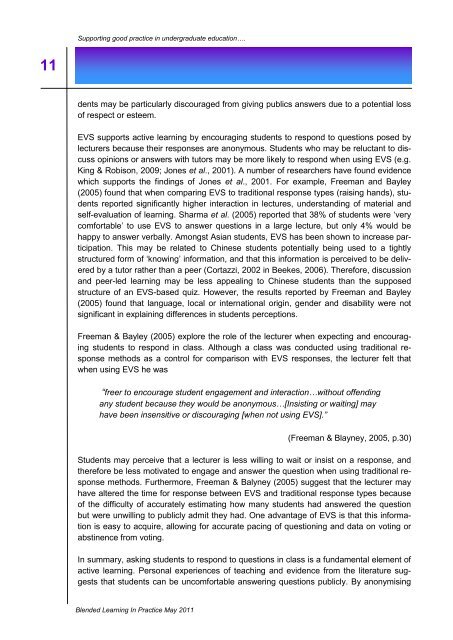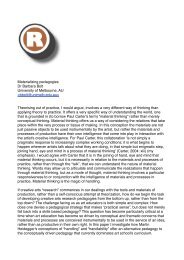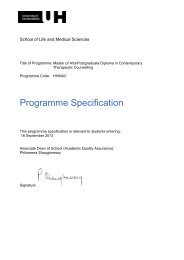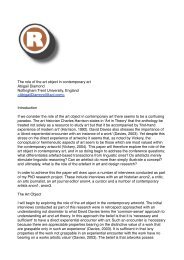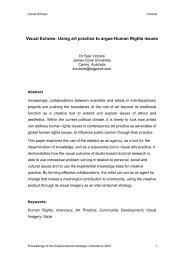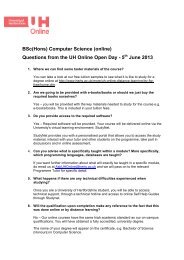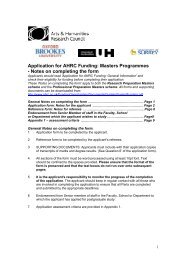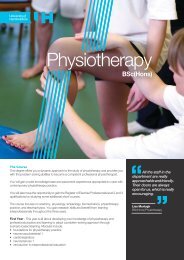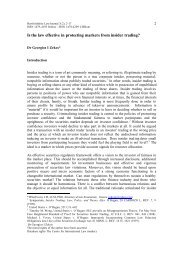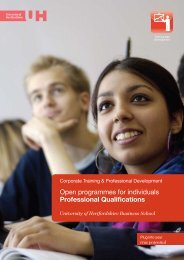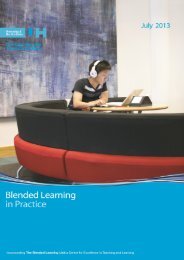3 - University of Hertfordshire
3 - University of Hertfordshire
3 - University of Hertfordshire
You also want an ePaper? Increase the reach of your titles
YUMPU automatically turns print PDFs into web optimized ePapers that Google loves.
Supporting good practice in undergraduate education….11dents may be particularly discouraged from giving publics answers due to a potential loss<strong>of</strong> respect or esteem.EVS supports active learning by encouraging students to respond to questions posed bylecturers because their responses are anonymous. Students who may be reluctant to discussopinions or answers with tutors may be more likely to respond when using EVS (e.g.King & Robison, 2009; Jones et al., 2001). A number <strong>of</strong> researchers have found evidencewhich supports the findings <strong>of</strong> Jones et al., 2001. For example, Freeman and Bayley(2005) found that when comparing EVS to traditional response types (raising hands), studentsreported significantly higher interaction in lectures, understanding <strong>of</strong> material andself-evaluation <strong>of</strong> learning. Sharma et al. (2005) reported that 38% <strong>of</strong> students were „verycomfortable‟ to use EVS to answer questions in a large lecture, but only 4% would behappy to answer verbally. Amongst Asian students, EVS has been shown to increase participation.This may be related to Chinese students potentially being used to a tightlystructured form <strong>of</strong> „knowing‟ information, and that this information is perceived to be deliveredby a tutor rather than a peer (Cortazzi, 2002 in Beekes, 2006). Therefore, discussionand peer-led learning may be less appealing to Chinese students than the supposedstructure <strong>of</strong> an EVS-based quiz. However, the results reported by Freeman and Bayley(2005) found that language, local or international origin, gender and disability were notsignificant in explaining differences in students perceptions.Freeman & Bayley (2005) explore the role <strong>of</strong> the lecturer when expecting and encouragingstudents to respond in class. Although a class was conducted using traditional responsemethods as a control for comparison with EVS responses, the lecturer felt thatwhen using EVS he was“freer to encourage student engagement and interaction…without <strong>of</strong>fendingany student because they would be anonymous…[Insisting or waiting] mayhave been insensitive or discouraging [when not using EVS].”(Freeman & Blayney, 2005, p.30)Students may perceive that a lecturer is less willing to wait or insist on a response, andtherefore be less motivated to engage and answer the question when using traditional responsemethods. Furthermore, Freeman & Balyney (2005) suggest that the lecturer mayhave altered the time for response between EVS and traditional response types because<strong>of</strong> the difficulty <strong>of</strong> accurately estimating how many students had answered the questionbut were unwilling to publicly admit they had. One advantage <strong>of</strong> EVS is that this informationis easy to acquire, allowing for accurate pacing <strong>of</strong> questioning and data on voting orabstinence from voting.In summary, asking students to respond to questions in class is a fundamental element <strong>of</strong>active learning. Personal experiences <strong>of</strong> teaching and evidence from the literature suggeststhat students can be uncomfortable answering questions publicly. By anonymisingBlended Learning In Practice May 2011


